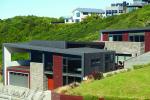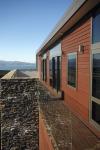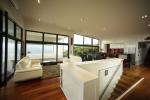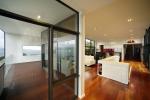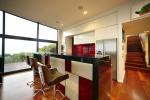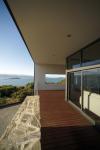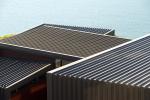Cascade House
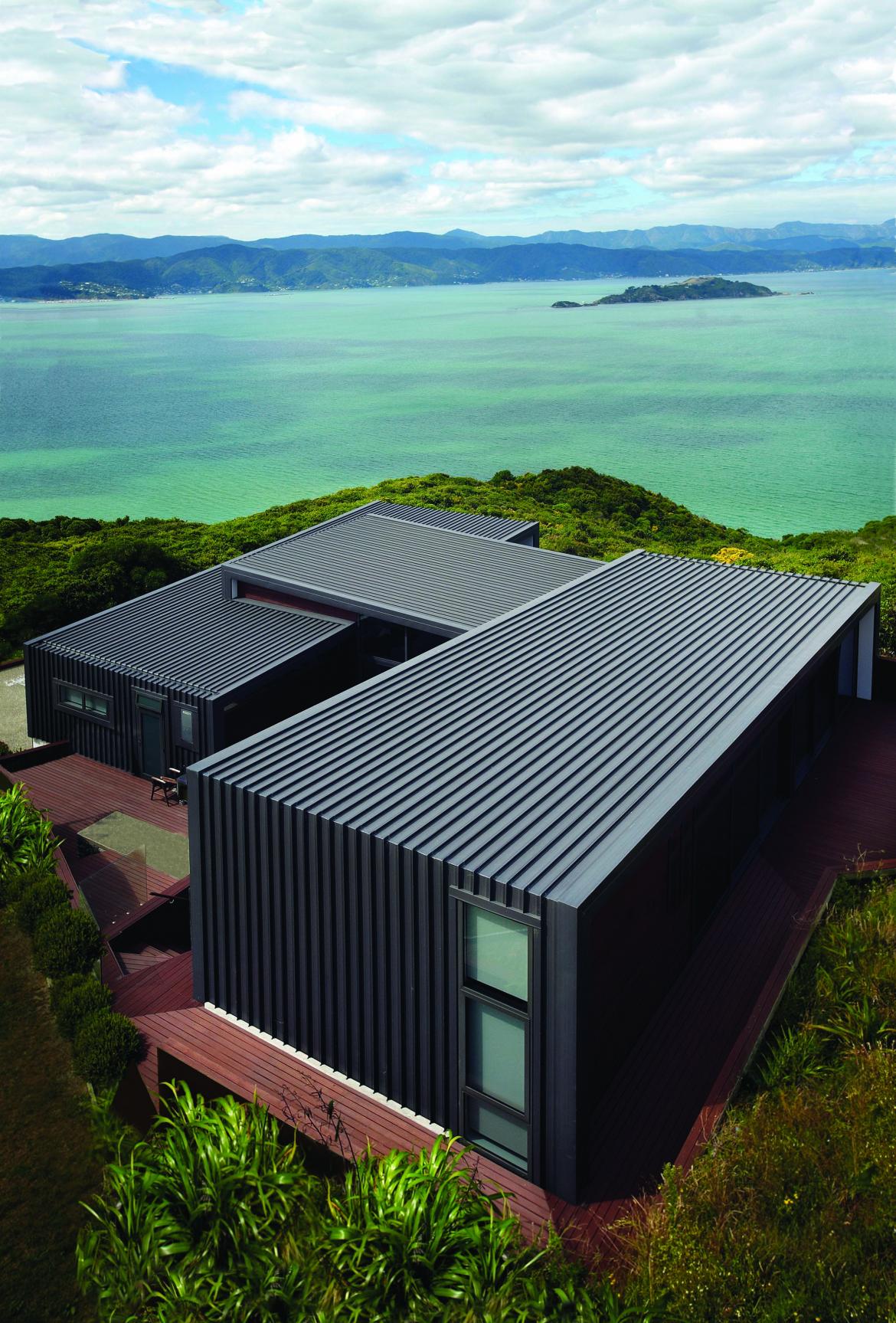
This new 309 square meter cascading house is perched on a cliff, on the southern border of the of Seagrove Conservation Estate, in the Wellington suburb of Newlands. The site offers amazing, panoramic views of Wellington harbour and is less than couple of hundred meters from the shoreline. Clearly the primary reason the client’s, Samir and Ketna Parekh, purchased this site was to take full advantage of the surrounding bush and seascape.
To create a home that was in harmony with the surrounding landscape, to take into account the slope, access, the neighbouring homes, planning requirements and limitations and to meet the clients brief and budget was not a simple task.
The site position and orientation is predominantly in a north/south direction with contour differences of over 11 meters from the top to the vehicle access at the bottom.
“We were fortunate,” says architect Davor Mikulcic, “ that our client worked with us and gave us the freedom to express our ideas. The family requirements were clear and we were able to reach agreement on key factors at an early stage in the design process.”
The objective on such a sensitive site was to touch the ground gently, to avoid scaring the site with significant cuts and fills, and use the slope to the best advantage in creating indoor and outdoor living spaces.
During the initial concept stage activities were grouped into individual zones, which helped to establish the design requirements further. The simple overlapping of individual blocks, dedicated to
specific activities, that followed the sloping contour of the site provided many advantages and achieved some of the key goals. The final design is in essence a three storied building but rather than simply stack the stories on top of each other, to reduce the cost and footprint, an interesting cascading form of platforms is created. This maximizes the best views, efficiently captures the sunlight and enables the creation of semi enclosed, open and sheltered courtyard spaces. The layering of the design avoids indoor and outdoor living spaces that simply float in the air.
Another very real consideration was the exposed nature of the site which is often buffered by strong southerly wind and rain and opposing this is the warmer, but strong westerly wind. The semi enclosed courtyard areas provide the best opportunity for sheltered outdoor activities.
To strategically take full advantage of the sloping site and to maximize the view, the decision was made to push the building, as much as practical, towards the back and towards the highest part of the property. This provided a large, flat front area for car access, turning and visitor car parking. One of the very early decisions was to limit the buildings height so as not to obstruct the view of any of the neighbouring houses to the rear, This location also put the home a reasonable distance from the houses below.
“Our design research used a combination of free hand sketches, scale and computer models, investigation with manufacturers and installers.” says Davor,” Our goal was to assist our team in delivering the best results in innovative products and design solutions for the project, the site and client. The research encompasses every aspect of the project from landscaping, engineering, interiors and all other aspects of the building process.”
Studio MWA was given full freedom from their clients to choose the best and the most appropriate finishes for this project. When addressing the exterior finishes, it was recognized that the chosen materials must be versatile, hardy and to emphasize the architectural composition and design intention.
The key factors which influenced the design and the choice of materials was the site location close to the sea, the tough climate conditions which will bombard the building and that the specific design came within the wind zone area of the building code. The clients required a tough low maintenance, cost effective solution for the exterior cladding.
A combination of concrete foundations and concrete block retaining walls helps to balance and minimize the quantity of cut and fill and to retain the majority of the soil on the site. The surrounding native bush was maintained and protected as much as possible. The elegant steel portal frames, posts and beams together with timber framing was chosen to be the main building structure in order to create the interesting folded cascading form.
Having experiencing similar demands on previous projects it was decided that the dominant material should be COLORSTEEL® roofing and wall cladding. Hidden clip fastening was used to further eliminate many penetrations on both the roof and wall cladding.
Dimondek 400 – COLORSTEEL® Maxx 0.55 BMT mm was specified. COLORSTEEL® Maxx flashings matched the roofing/wall claddings.
Due to the extensive glazing, to capture the view and sun, there was a requirement to have top quality thermal insulation for the external walls and roof.
Natural materials were used to help blend with the environment and compliment the COLORSTEEL® cladding. Hardwood decking, schist, cedar weatherboards, timber retaining walls and locally sourced exposed aggregate concrete for the driveway all added texture and softened the overall effect. Strategically located schist walls are inspired by the rocks from the local cliffs and the COLORSTEEL® roof and wall cladding, grey tinted glass and the aluminium joinery also reflect the pallet of the indigenous the rocks and landscape in the surrounding natural environment.
The project brief required that the house be a four-bedroom home, with two living areas, a prayer nook, rumpus /studio area, double garage with storage area, an ensuite, main bathroom, separate toilet and laundry area with plenty of sheltered outdoor areas – opened and covered, including a BBQ area with an outdoor open fire and spa pool area accessible from the Master bedroom.
The ground level is occupied by a double garage with storage areas on the southern side and on the northern side a large rumpus room which could be used as a studio /office space or a fifth bedroom with walk-in wardrobe and ensuite.
The main entrance is centrally located and covered to offer protection from the elements.
One of the early design decisions
was to create a central spine from the entry for easy communication and navigation through the building. It resulted in the entry hall which accommodates large storage cupboards and internal access from the garage. A straight flight of stairs, with an internal garden, leads to the central level featuring an open plan kitchen, living and dining area that provides easy access to the Master bedroom and prayer nook. All located towards the front of the house capturing the incredible views over the Wellington Harbour.
Close to the top of these stairs is access to the sheltered North courtyard and on the opposite side another, semi covered and partially enclosed outdoor living area. On this level is a formal lounge that open towards the courtyard that enjoys the rising sun in the east. When required the lounge can be fully enclosed by large sliding glass panels and doubles as a home theatre.
Behind the kitchen is a separate service area which accommodates a toilet and laundry with access to the sheltered rear deck with a foldable clothesline. Overall the central level occupies nearly 50 % of the home.
Flowing up from the entry hall and lower steps is a second straight flight of steps to a private, fully east orientated bedroom block which includes three double bedrooms with the main bathroom. A glazed hallway towards the west connects the bedrooms and bathroom. From this hallway there is easy access, via large sliding glass doors, to the sheltered western deck. The top three bedrooms open onto the eastern terraces with the view towards Wellington harbour.
This flowing, cascading home blends and celebrates the natural environment both in its form, style and material choice. It is a hardy celebration of all that is New Zealand and sits comfortably into the local landscape.


